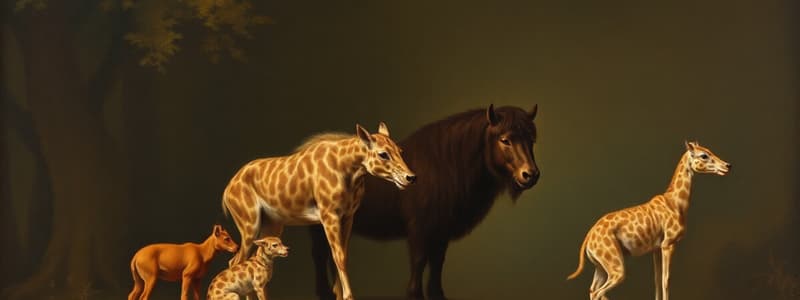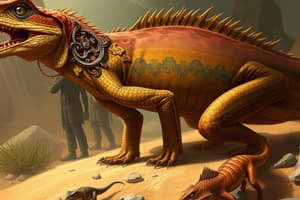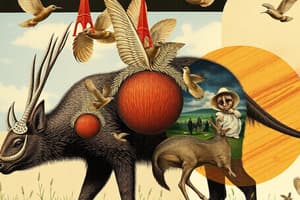Podcast
Questions and Answers
What is the primary function of spiracles in the tracheal system?
What is the primary function of spiracles in the tracheal system?
- Permitting closure to reduce water loss (correct)
- Facilitating oxygen transport in soil
- Enhancing gas diffusion in water
- Increasing metabolic rates during desiccation
What is the term for the resistant stage formed by tardigrades in response to dehydration?
What is the term for the resistant stage formed by tardigrades in response to dehydration?
- Aestivation
- Anhydrobiosis
- Desiccation tolerance
- Cryptobiosis (correct)
Under which conditions do rotifers typically reproduce sexually?
Under which conditions do rotifers typically reproduce sexually?
- In any environment to ensure population growth
- In dry, stressed environments for genetic variability (correct)
- During periods of extreme hydration
- In moist environments without stress
Which of the following describes the state of metabolism in desert-dwelling spadefoot toads during aestivation?
Which of the following describes the state of metabolism in desert-dwelling spadefoot toads during aestivation?
Which advantage does breathing air have over breathing water?
Which advantage does breathing air have over breathing water?
What is a disadvantage of gas exchange through air?
What is a disadvantage of gas exchange through air?
Which method do vertebrate lungs use for gas exchange?
Which method do vertebrate lungs use for gas exchange?
How do spiracles contribute to moisture retention in terrestrial organisms?
How do spiracles contribute to moisture retention in terrestrial organisms?
What adaptation helps to protect embryos from desiccation in terrestrial life?
What adaptation helps to protect embryos from desiccation in terrestrial life?
Which of the following is true about amphibians' reproduction?
Which of the following is true about amphibians' reproduction?
What mechanism do terrestrial animals primarily use to regulate body temperature?
What mechanism do terrestrial animals primarily use to regulate body temperature?
Which strategy involves maintaining a constant body temperature regardless of environmental changes?
Which strategy involves maintaining a constant body temperature regardless of environmental changes?
What does the term 'isothermic' describe in aquatic organisms?
What does the term 'isothermic' describe in aquatic organisms?
Which type of eggs helps conserve water during reproduction on land?
Which type of eggs helps conserve water during reproduction on land?
What is a potential disadvantage of being ectothermic?
What is a potential disadvantage of being ectothermic?
What is the primary method of heat transfer through direct contact?
What is the primary method of heat transfer through direct contact?
What is the primary reason that terrestrial animals need to avoid desiccation?
What is the primary reason that terrestrial animals need to avoid desiccation?
Which animal phylum is noted as being completely terrestrial?
Which animal phylum is noted as being completely terrestrial?
What adaptation in mammals supports greater water conservation during urine excretion?
What adaptation in mammals supports greater water conservation during urine excretion?
How do reptiles, birds, and insects primarily manage the excretion of nitrogenous wastes?
How do reptiles, birds, and insects primarily manage the excretion of nitrogenous wastes?
Which factor is NOT a challenge faced by terrestrial animals compared to aquatic environments?
Which factor is NOT a challenge faced by terrestrial animals compared to aquatic environments?
What is the primary role of the cuticle in insects regarding desiccation?
What is the primary role of the cuticle in insects regarding desiccation?
Why do terrestrial environments pose a greater challenge for gas exchange compared to aquatic environments?
Why do terrestrial environments pose a greater challenge for gas exchange compared to aquatic environments?
What successful strategy do kangaroo rats use to manage water in their desert environment?
What successful strategy do kangaroo rats use to manage water in their desert environment?
What is a significant adaptation terrestrial animals developed to perform gas exchange while reducing water loss?
What is a significant adaptation terrestrial animals developed to perform gas exchange while reducing water loss?
Which condition affects the anatomy and physiology of terrestrial animals due to limited water availability?
Which condition affects the anatomy and physiology of terrestrial animals due to limited water availability?
What is the primary function of countercurrent heat exchange in cold-climate terrestrial endotherms?
What is the primary function of countercurrent heat exchange in cold-climate terrestrial endotherms?
Which of the following describes the process of torpor?
Which of the following describes the process of torpor?
How do heterothermic endotherms, such as bees, generate and maintain their body temperature?
How do heterothermic endotherms, such as bees, generate and maintain their body temperature?
What distinguishes freeze tolerance from freeze avoidance in ectotherms?
What distinguishes freeze tolerance from freeze avoidance in ectotherms?
What is the main implication of allometric growth in terrestrial organisms?
What is the main implication of allometric growth in terrestrial organisms?
Which factor primarily affects the support and strength of limbs in terrestrial animals?
Which factor primarily affects the support and strength of limbs in terrestrial animals?
In the context of insects, what allows some to be considered heterothermic endotherms?
In the context of insects, what allows some to be considered heterothermic endotherms?
What is a characteristic feature of isometric growth as seen in ants?
What is a characteristic feature of isometric growth as seen in ants?
What is the primary function of skeletons in animals?
What is the primary function of skeletons in animals?
What material primarily composes the arthropod exoskeleton?
What material primarily composes the arthropod exoskeleton?
Which type of skeleton allows for muscles to be located internally?
Which type of skeleton allows for muscles to be located internally?
What challenge does water pose to aquatic animals in terms of movement?
What challenge does water pose to aquatic animals in terms of movement?
How does water's high thermal conductance affect aquatic animals?
How does water's high thermal conductance affect aquatic animals?
What characteristic differentiates terrestrial and aquatic endoskeletons?
What characteristic differentiates terrestrial and aquatic endoskeletons?
What is a function of hydrostatic skeletons in animals?
What is a function of hydrostatic skeletons in animals?
What adaptation do aquatic animals have in response to the challenges of low oxygen content in water?
What adaptation do aquatic animals have in response to the challenges of low oxygen content in water?
Which mechanism allows the embryo in an amniotic egg to efficiently exchange gases and wastes?
Which mechanism allows the embryo in an amniotic egg to efficiently exchange gases and wastes?
What is a significant advantage of uricotely in terrestrial animals?
What is a significant advantage of uricotely in terrestrial animals?
Which of the following describes a common adaptation in vertebrates that helps support body weight?
Which of the following describes a common adaptation in vertebrates that helps support body weight?
What is an example of a behavior that most terrestrial animals use for thermoregulation?
What is an example of a behavior that most terrestrial animals use for thermoregulation?
What characteristic of the amniotic egg's shell is crucial for its function?
What characteristic of the amniotic egg's shell is crucial for its function?
What process results in the formation of a resistant tun in tardigrades during periods of slow desiccation?
What process results in the formation of a resistant tun in tardigrades during periods of slow desiccation?
Which reproductive strategy do rotifers employ in a stressed (dry) environment?
Which reproductive strategy do rotifers employ in a stressed (dry) environment?
What adaptation do some desert-dwelling frogs utilize while aestivating to minimize water loss?
What adaptation do some desert-dwelling frogs utilize while aestivating to minimize water loss?
Which internal structure is primarily used by terrestrial animals for gas exchange while reducing water loss?
Which internal structure is primarily used by terrestrial animals for gas exchange while reducing water loss?
What is a significant disadvantage of breathing air for terrestrial organisms?
What is a significant disadvantage of breathing air for terrestrial organisms?
What mechanism do terrestrial organisms employ to replace lost water due to desiccation?
What mechanism do terrestrial organisms employ to replace lost water due to desiccation?
In what way does the gas exchange system of vertebrate lungs differ from insect tracheal systems?
In what way does the gas exchange system of vertebrate lungs differ from insect tracheal systems?
How does the metabolic activity of desert-dwelling spadefoot toads change while they are buried during aestivation?
How does the metabolic activity of desert-dwelling spadefoot toads change while they are buried during aestivation?
Which factor primarily affects the locomotion of terrestrial animals compared to aquatic animals?
Which factor primarily affects the locomotion of terrestrial animals compared to aquatic animals?
What adaptation do reptiles, birds, and insects utilize for excreting nitrogenous wastes?
What adaptation do reptiles, birds, and insects utilize for excreting nitrogenous wastes?
What physiological adaptation do mammals possess to conserve water during urine excretion?
What physiological adaptation do mammals possess to conserve water during urine excretion?
Which mechanism is NOT involved in the desiccation avoidance strategies of terrestrial animals?
Which mechanism is NOT involved in the desiccation avoidance strategies of terrestrial animals?
Which aspect of terrestrial life is primarily influenced by the limited availability of water?
Which aspect of terrestrial life is primarily influenced by the limited availability of water?
Which anatomical feature is particularly designed to minimize water loss during gas exchange in terrestrial animals?
Which anatomical feature is particularly designed to minimize water loss during gas exchange in terrestrial animals?
Why is metabolic water significant for desert-adapted animals like kangaroo rats?
Why is metabolic water significant for desert-adapted animals like kangaroo rats?
What is a potential consequence of the cube-square relationship for small terrestrial animals?
What is a potential consequence of the cube-square relationship for small terrestrial animals?
Which term describes the adaptation of animals to cope with prolonged periods of low water availability?
Which term describes the adaptation of animals to cope with prolonged periods of low water availability?
What key challenge do terrestrial animals face that is less prominent in aquatic environments?
What key challenge do terrestrial animals face that is less prominent in aquatic environments?
Flashcards
Terrestrial animals
Terrestrial animals
Land-dwelling animals that evolved from aquatic ancestors.
Desiccation
Desiccation
The removal of water from a substance or living being through evaporation.
Nitrogenous waste
Nitrogenous waste
Toxic byproducts of metabolism of proteins and nucleic acids.
Uric acid
Uric acid
Signup and view all the flashcards
Urea
Urea
Signup and view all the flashcards
Loop of Henle
Loop of Henle
Signup and view all the flashcards
Excretion
Excretion
Signup and view all the flashcards
Gas exchange (terrestrial animals)
Gas exchange (terrestrial animals)
Signup and view all the flashcards
Cuticle
Cuticle
Signup and view all the flashcards
Trachea
Trachea
Signup and view all the flashcards
Desiccation Tolerance
Desiccation Tolerance
Signup and view all the flashcards
Cryptobiosis
Cryptobiosis
Signup and view all the flashcards
Anhydrobiosis
Anhydrobiosis
Signup and view all the flashcards
Insect Tracheal System
Insect Tracheal System
Signup and view all the flashcards
Vertebrate Lungs
Vertebrate Lungs
Signup and view all the flashcards
Ventilation
Ventilation
Signup and view all the flashcards
Tracheal system closing
Tracheal system closing
Signup and view all the flashcards
Aestivation
Aestivation
Signup and view all the flashcards
Amniotic egg
Amniotic egg
Signup and view all the flashcards
Thermoregulation
Thermoregulation
Signup and view all the flashcards
Endotherm
Endotherm
Signup and view all the flashcards
Ectotherm
Ectotherm
Signup and view all the flashcards
Internal fertilization
Internal fertilization
Signup and view all the flashcards
Uricotely
Uricotely
Signup and view all the flashcards
Gamete Desiccation
Gamete Desiccation
Signup and view all the flashcards
Thermoregulation constraints
Thermoregulation constraints
Signup and view all the flashcards
Convection
Convection
Signup and view all the flashcards
Evaporation
Evaporation
Signup and view all the flashcards
Countercurrent heat exchange
Countercurrent heat exchange
Signup and view all the flashcards
Torpor
Torpor
Signup and view all the flashcards
Allometry
Allometry
Signup and view all the flashcards
Freeze Avoidance
Freeze Avoidance
Signup and view all the flashcards
Freeze Tolerance
Freeze Tolerance
Signup and view all the flashcards
Body Weight Support (Allometry)
Body Weight Support (Allometry)
Signup and view all the flashcards
Allometric Growth
Allometric Growth
Signup and view all the flashcards
Exoskeleton
Exoskeleton
Signup and view all the flashcards
Endoskeleton
Endoskeleton
Signup and view all the flashcards
Mineral Bank
Mineral Bank
Signup and view all the flashcards
Chitin
Chitin
Signup and view all the flashcards
Hydrostatic Skeleton
Hydrostatic Skeleton
Signup and view all the flashcards
Water Density
Water Density
Signup and view all the flashcards
Water Viscosity
Water Viscosity
Signup and view all the flashcards
Waterproof Coating
Waterproof Coating
Signup and view all the flashcards
Internalized Gas Exchange
Internalized Gas Exchange
Signup and view all the flashcards
Cube-Square Relationship
Cube-Square Relationship
Signup and view all the flashcards
Support body weight
Support body weight
Signup and view all the flashcards
Tardigrade's Anhydrobiosis
Tardigrade's Anhydrobiosis
Signup and view all the flashcards
Rotifer's Sexual Reproduction
Rotifer's Sexual Reproduction
Signup and view all the flashcards
Gas Exchange with Air
Gas Exchange with Air
Signup and view all the flashcards
Disadvantage of Air Breathing
Disadvantage of Air Breathing
Signup and view all the flashcards
Vertebrate Lung Function
Vertebrate Lung Function
Signup and view all the flashcards
Protecting Gametes from Desiccation
Protecting Gametes from Desiccation
Signup and view all the flashcards
Study Notes
Terrestrial Animals
- Animals originated in the oceans
- Terrestrial land-dwelling animals are descended from ancestors that left aquatic environments
- Earliest recorded terrestrial animal was a myriapod, 428 million years ago
- Transitions to life on land occurred earlier than the documented myriapod
- Few animal taxa have made this transition
- Examples of terrestrial animal taxa are gastropods, arthropods (insects, arachnids, myriapods, crustaceans), nematodes, and annelids, amniote vertebrates
- Terrestrial environments offer many evolutionary opportunities
Conditions on Land
- Terrestrial environments present different demands compared to aquatic environments
- Gravity is a crucial factor influencing posture and locomotion
- Air is less dense than water affecting oxygen acquisition
- Obtaining and conserving water is a critical concern for terrestrial animals
- Locomotion and sensory modes in terrestrial environments differ from those in aquatic environments
- Sunlight and UV exposure are important aspects of terrestrial environments
Life on Land
- Key requirement for terrestrial life is the avoidance of desiccation
- Desiccation avoidance involves mechanisms for reducing water loss, replacing lost water, and adaptations in excretion
- Excretion with limited water loss is critical
- Internal gas exchange organs (lungs, book lungs, tracheal systems) are vital for avoiding desiccation
Desiccation and The Environment- Terrestrial Animals
- Terrestrial animals are greatly influenced by water availability
- Factors like physiology, behaviour, and anatomy are influenced by the availability of water
- Constant water loss through evaporation is common in a terrestrial environment
- Effects of evaporation are seen in the respiratory membrane
Part II: Desiccation and The Environment- Terrestrial Animals
- Mammals typically excrete urea (a less toxic substance than ammonia)
- Loops of Henle are crucial for retaining water in mammals' urine
- Rodents like kangaroos have long loops of Henle, promoting concentrated urine production
- Metabolic water is a significant source of water in some terrestrial environments
Insects
- Insects must manage evaporation in relation to their small size
- Cuticular waxes minimize evaporation from the body surface
- Spiracles (breathing pores) can close to reduce water loss
Freeze Tolerance
- Freeze avoidance (supercooling ECF): Some ectotherms can supercool without freezing
- Freeze tolerance: Some terrestrial ectotherms allow ECF to freeze for periods.
- Controlling ice nucleation in ECF is vital for the survival of these ectotherms
Allometric Growth
- Allometric growth is the characteristic whereby different body parts grow at varying rates, depending on changes in overall animal size
- This pattern of growth often reflects evolutionary trends influencing body size in lineages
- Limbs in animals must demonstrate allometric growth to ensure sufficient structural integrity in keeping with the body size
Skeleton Types
- Exoskeletons and endoskeletons are the two types of hard skeletons occurring in terrestrial and aquatic animals
- Skeletons serve purposes of providing attachment points for muscles, transmitting compressive stresses, serving as a framework for body structures and protecting various delicate body organs
Aquatic Animals
- Water supports the body, reducing the need for strong structural adaptations
- Lack of desiccation pressures makes aquatic environments suitable for various forms of life
- Aquatic environments provide stable and mild temperatures
- Sound transmits effectively in water
Challenges of Living in Aquatic Environments
- Water's density and viscosity cause resistance to movement
- Low oxygen concentrations in water pose challenges
- Water conducts heat quickly compared to air
- Water balance (salt and water balance)
Warm Aquatic Adaptations
- Insulating blubber or pelage prevents heat loss
- Respiratory exchange facilitates high metabolic rates
- Countercurrent heat exchange conserves heat by passing warm outbound blood to cool inbound blood within an organ
Studying That Suits You
Use AI to generate personalized quizzes and flashcards to suit your learning preferences.
Description
This quiz explores the evolution of terrestrial animals and the adaptations they have made to thrive on land. It delves into the conditions of terrestrial environments and how these conditions differ from aquatic life. Test your knowledge on various taxa and their evolutionary journeys from water to land.




